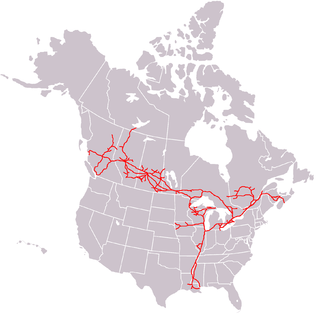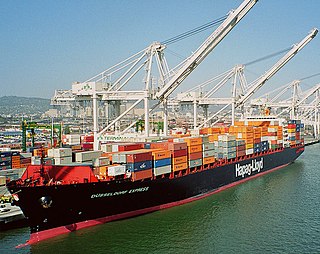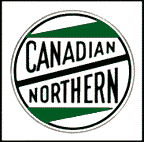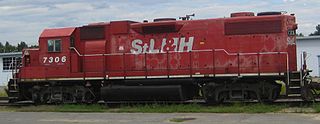
The Canadian Pacific Railway, also known simply as CPR or Canadian Pacific and formerly as CP Rail (1968–1996), was a Canadian Class I railway incorporated in 1881. The railway was owned by Canadian Pacific Railway Limited, which began operations as legal owner in a corporate restructuring in 2001.

The Canadian National Railway Company is a Canadian Class I freight railway headquartered in Montreal, Quebec, which serves Canada and the Midwestern and Southern United States.

Hapag-Lloyd AG is a German international shipping and container transportation company, the 4th biggest in the world. It was formed in 1970 through a merger of Hamburg-American Line (HAPAG) and Norddeutscher Lloyd.

Kansas City Southern (KCS) was a pure transportation holding company with railroad investments in the United States, Mexico, and Panama. The KCS rail network included about 7,299 miles (11,747 km) of track in the U.S. and Mexico.

The Canadian Northern Railway (CNoR) was a historic Canadian transcontinental railway. At its 1923 merger into the Canadian National Railway, the CNoR owned a main line between Quebec City and Vancouver via Ottawa, Winnipeg, and Edmonton.
Fairmont Hotels & Resorts is a global chain of luxury hotel that operates more than 70 properties worldwide, with a strong presence in Canada.

The St. Lawrence and Hudson Railway was a wholly owned subsidiary of the Canadian Pacific Railway.

Kansas City Southern de México, S.A. de C.V. was a Mexican railroad and operating subsidiary of Kansas City Southern (KCS). The company was founded in 1996 as Transportación Ferroviaria Mexicana, a joint venture between KCS and Transportación Maritima Mexicana after the companies won a concession from the Mexican government to operate the 5,335-kilometer (3,315 mi) Northeast Railroad connecting Monterrey and Mexico City with a US port of entry at Laredo, Texas and seaports at Lázaro Cárdenas and Veracruz. In 2005, KCS bought out its partner's shares in the railroad, giving it full control.
The New Brunswick Railway Company Limited (NBR) is currently a Canadian non-operating railway and land holding company headquartered in Saint John, New Brunswick that is part of Irving Transportation Services, a division within the J.D. Irving Limited (JDI) industrial conglomerate. It is not to be confused with another JDI company, New Brunswick Southern Railway (NBSR), established in 1995, which is an operational railway and considered a sister company of the NBR.

The International Railway of Maine was a historic railroad constructed by the Canadian Pacific Railway (CPR) between Lac-Mégantic, Quebec, and Mattawamkeag, Maine, closing a key gap in the railway's transcontinental main line to the port of Saint John, New Brunswick.

Allstream is a business communications provider based in Mississauga, Ontario, Canada, that provides Internet Protocol (IP) connectivity, managed IP services, unified communications and voice services to its customers in the United States and Canada.

CP Ships was a large Canadian shipping company established in the 19th century. From the late 1880s until after World War II, the company was Canada's largest operator of Atlantic and Pacific steamships. Many immigrants travelled on CP ships from Europe to Canada. In the early 20th century the sinking of the Canadian Pacific steamship RMS Empress of Ireland just before World War I became largest maritime disaster in Canadian history. The company provided Canadian Merchant Navy vessels in World Wars I and II. Twelve vessels were lost due to enemy action in World War II, including the RMS Empress of Britain, which was the largest ship ever sunk by a German U-boat.

The Canadian Pacific Kansas City Police Service (CPKC Police Service) (formerly known as Canadian Pacific Police Service (CPPS)) is a private railroad police force enforcing safety and policing along Canadian Pacific Kansas City properties and rail lines in Canada and the United States, including limited sections of the Milton line of GO Transit in the Greater Toronto Area which is being secured by its Transit Safety Officers.
CNCP Telecommunications was an electrical telegraph operator and later a telecom company, which operated between 1967 and 1990.

The British Columbia Maritime Employers Association is an association representing the interests of member companies in industrial relations on Vancouver's and other British Columbian seaports.

The Multimark was a logo introduced by Canadian Pacific Railway on June 17, 1968, to identify each of its various operations.

The Texas Mexican Railway International Bridge is an international railway bridge across the Rio Grande and U.S.-Mexico border between Laredo, Texas, and Nuevo Laredo, Tamaulipas, the only rail link between these cities. Owned and operated by CPKC, the single-track bridge is the busiest rail border crossing in North America. It is also known as the Laredo International Railway Bridge and Puente Negro.

The Canadian Pacific Railway Upper Lake Service, also known as the Canadian Pacific Railway Upper Lake Steamships, was a division of Canadian Pacific Railway (CPR), which began operating passenger and cargo shipping routes in the Great Lakes during the late 19th century.
PanCanadian Petroleum Limited was a Canadian independent petroleum company that operated between 1971 and 2002. The company was created through the merger of Canadian Pacific Oil and Gas Limited and Central-Del Rio Oils Limited. PanCanadian inherited the freehold leases on land grants the Canadian Pacific Railway had received in the 1880s, and therefore possessed a massive land base to explore for oil and gas. Through its entire life, PanCanadian was owned approximately 87 percent by the CPR's holding company. In 2002, PanCanadian merged with the Alberta Energy Company to form EnCana, which at the time was the world's largest independent petroleum company.

The history of the Canadian Pacific Railway dates back to 1873. Together with the Canadian Confederation, the creation of the Canadian Pacific Railway was a task originally undertaken as the "National Dream" by the Conservative government of Prime Minister John A. Macdonald. He was helped by Alexander Tilloch Galt, who was the owner of the North Western Coal and Navigation Company. British Columbia, a four-month sea voyage away from the East Coast, had insisted upon a land transport link to the East as a condition for joining Confederation, after initially requesting a wagon road.

















